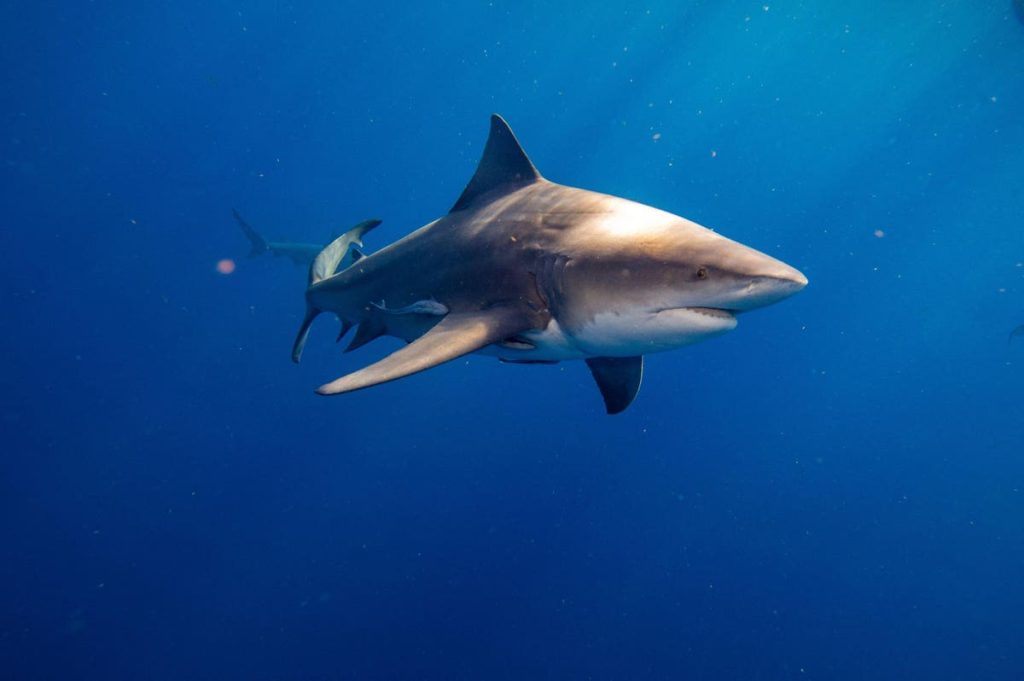In a remarkable scientific study featured in the journal Marine and Fishery Sciences, researchers shed light on extraordinary adaptation of bull sharks (Carcharhinus leucas) to a surprising habitat: a freshwater golf course lake near Brisbane, Australia.
The bull shark (Carcharhinus leucas) is renowned for its remarkable ability to venture deep into freshwater environments in tropical, subtropical, and warm-temperate regions around the world. Uniquely adapted for life in both freshwater and saltwater environments, they seem to prefer estuaries, river mouths, and coastal areas that provide access to both marine and freshwater prey, making them ideal hunting grounds for these sharks. Bull sharks also move between saltwater and freshwater environments as they seek mates and safe breeding areas. Uniquely adapted for life in both freshwater and saltwater environments, these sharks possess specialized physiological adaptations that enable them to regulate their internal salt levels. Bull sharks have specialized glands, known as rectal glands, located near their cloaca (the opening used for reproduction and waste elimination), which help them excrete excess salts from their body. This helps them prevent dehydration in freshwater and excessive salt intake in the ocean. During their early life stages, young bull sharks depend on low-salinity habitats, such as rivers and estuaries, which serve as crucial nursery areas, and can spend up to five years in these low-salinity environments, where they face lower predation risks from larger sharks. As they grow up, they can embark on extensive migrations in major rivers spanning thousands of kilometers, including the Amazon, Mississippi, and Zambezi rivers. Unfortunately, the bull shark faces multiple threats due to global changes in coastal inshore habitats, as well as estuarine and riverine systems, coupled with fishing pressures throughout its range. Consequently, the bull shark has been classified as Vulnerable (VU) on a global scale according to the IUCN Red List.
How exactly did a golf course become filled with bull sharks? One theory is that the golf course lake became home to these sharks after a series of significant floods in the nearby Logan and Albert rivers between 1991 and 1996. These floods inundated the golf course, allowing the bull sharks to enter the lake. As the floodwaters receded, the sharks became trapped. While the exact date of their arrival and the number of sharks that entered initially are unknown, they were first reported in the lake in 1996. Subsequently, media reports indicated that bull sharks were regularly seen in the lake during the late 1990s and early 2000s. And while golf courses around the world are no stranger to toothy residents (for example, there are hundreds of videos shared online of giant alligators lounging across courses in Florida), this specific ‘mascot’ of sort is unique. Yet the company has used their sharks as an engaging educational exhibit for the public. Still, to minimize potential interactions between sharks and golf course users, warning signs were strategically placed around the lake, alerting players to the potential presence of bull sharks.
These sharks have been isolated in this environment for more than a decade and have offered researchers a unique opportunity to study the species’ adaptability to low-salinity habitats, as well as questions about their diet, reproduction, and longevity in captivity. The challenges faced by these sharks include illegal fishing activities within the lake, resulting in the unfortunate end of at least one individual. While the lake was stocked with potential prey species, the golf club staff occasionally provided meat to encourage the sharks’ presence. Which is good because the new study estimated that each bull shark residing in the golf course lake required approximately 0.44% of its body weight in prey per day to meet its daily energy needs. Over a week, this translated to approximately 3.08% of its body weight, and over a year, it amounted to a significant quantity of prey, potentially close to half a ton of fish per year for a single shark. And it’s not known how many are still alive in there! The bull sharks in the lake were reportedly juveniles when they arrived, and there was no reliable information or signs indicating that they have successfully reproduced within this isolated freshwater setting. In fact, surprisingly, the last confirmed sighting of bull sharks in the lake occurred in 2015, and their current status remains a mystery, adding an intriguing layer to this small group. “It is currently unclear if new sharks arrived during the latest flood event in 2022,” the 17-year study author Peter Gausmann adds.
Landlocked populations of bull sharks, where these marine predators find themselves cut off from the open ocean and confined to freshwater environments, are a rare but intriguing phenomenon found in various parts of the world. Two prominent examples include South Africa’s Lake St. Lucia Estuary system and Panama’s Lake Bayano. In South Africa, the unique ecosystem of Lake St. Lucia, nestled within the iSimangaliso Wetland Park, a UNESCO World Heritage Site, has witnessed the isolation of bull sharks due to natural events. This isolation occurs when the estuary’s mouth becomes blocked, either by sandbars forming at the entrance or during periods of reduced river discharge, such as droughts. Despite facing challenges like hypersalinity and extreme temperature fluctuations, some bull sharks have managed to adapt and survive within the lake. Notably, Lake St. Lucia has become a vital nursery area for bull sharks in the southwestern Indian Ocean, illustrating their remarkable ability to thrive in diverse environments. On the other side of the globe, in Panama, the impoundment of the Bayano River led to the landlocked existence of bull sharks in Lake Bayano. Following the construction of a dam, the connection between the lake and the sea was severed. Researchers documented these bull sharks surviving in a pure freshwater setting for at least four years post-dam closure, although certain factors, such as potential exposure to herbicides, may have contributed to the demise of a few individuals. This case raises the possibility that bull sharks can endure even longer in such conditions. These cases underscore the species’ capacity to adapt to unconventional environments, be it due to natural phenomena like floods or human-made alterations such as dam construction.
“It would be desirable if newcoming sharks in the golf course lake were tagged, monitored long term, and examined in depth to gain more data on physiology and other life parameters,” Gausmann concludes. “Intensive baiting and fishing activity or the use of further investigation methods such as environmental DNA (eDNA) could bring clarification on [the status of the sharks]. For their detection and future observation, the collaboration between the officials of the Carbrook golf club and shark scientists [is needed].”
Read the full article here










